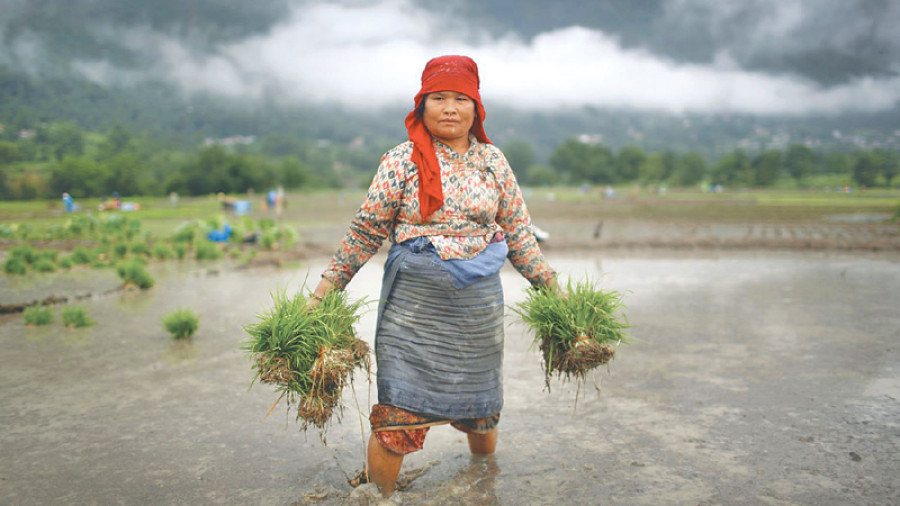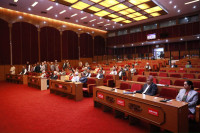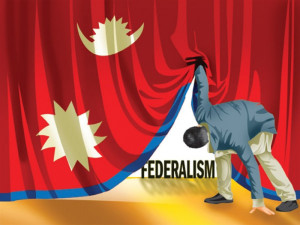Columns
Nepal’s climate-gender nexus
Women disproportionately suffer from climate change due to their primary roles in securing food, water and fuel.
Nischal Dhungel
Nepal faces the intertwined global issues of climate change and gender inequality. With a commitment to the Sustainable Development Goals (SDGs), especially SDG 5, which focuses on gender equality, Nepal is making strides in women’s empowerment. Ranked 99th out of 166 countries in sustainable development, the nation has shown progress, endorsing the Gender Equality Policy 2077 through the Ministry of Women, Children and Senior Citizens. This policy emphasises women’s economic empowerment, participation in society and eliminating gender-based violence. Additionally, the Provincial and Local Governance Support Programme’s Gender Equality and Social Inclusion Strategy further details approaches for mainstreaming gender and social inclusion, enhancing institutional capacities to promote these values at provincial and local levels.
Selected gender indicators
The journey towards gender parity in Nepal is far from complete. The educational divide persists, with women receiving only 66.9 percent of the mean years of education compared to men in 2021. The gender gap in labour force participation is stark, with only 28.6 percent of women compared to 53.1 percent of men participating in 2022. Compared with labour force participation in the lower-middle income group, the gap between men and women is lower in Nepal. This gap is compounded by the high rate of vulnerable employment among women (90 percent in 2020 and 2021), far exceeding men’s rate and surpassing regional averages (67.3 percent in 2020).
Such vulnerability places women at a greater risk of poverty; moreover, there is a lack of women’s representation in data concerning unpaid domestic and care work. Maternal health shows good progress; maternal mortality decreased from 504 per 100,000 live births in 2000 to 174 in 2020, still above the regional average (138). Additionally, adolescent fertility rates have declined but remain high, with 64 births per 1,000 girls aged 15-19 in 2021, indicating ongoing reproductive health issues. Despite this progress, women’s political representation is positive, holding 33.1 percent of parliamentary seats, consistent since 2010 and above the average for South Asia (18.2 percent) and lower-income countries (21.8 percent). Recently, Nepal also became the first South Asian country to register queer marriage.
Gender gap
The World Economic Forum’s Global Gender Gap Report 2023 indicates a protracted journey towards gender parity, estimating 131 years to close the global gender gap. The 17th iteration of the report benchmarks 146 countries across four dimensions: Economic participation and opportunity, educational attainment, health and survival and political empowerment. South Asia, with a gender parity score of 63.4 percent, is the second-lowest among eight regions, improving by 1.1 points since the last edition. This progress is attributed to countries like India, Pakistan, Bangladesh and Bhutan, each improving by at least 0.5 points. However, Sri Lanka, Afghanistan and Nepal have seen declines in gender parity.
In Nepal, the Gender Gap Index score fell from 0.692 in 2022 to 0.659 in 2023, dropping its rank from 96th to 116th. Economic participation and opportunity saw a significant decrease, from a score of 0.641 to 0.476, plummeting Nepal’s rank from 98th to 136th. Educational attainment slightly decreased from 0.916 to 0.918, with a rank fall from 125th to 127th. Health and survival improved, from a score of 0.965 to 0.969 and a rank from 109th to 82nd. However, political empowerment experienced a decrease in score from 0.247 to 0.276, with a decline in rank from 58th to 54th. Nepal’s widening gender gap, particularly in economic participation and opportunity, highlights the impact of the Covid-19 pandemic, which exacerbated gender inequalities. The pandemic led to job losses or reduced working hours for 1.6 to 2 million Nepali female workers, alongside significant wage reductions across various sectors.
Climate change and gender
Climate change and gender inequality are closely linked, necessitating urgent structural changes. The International Labour Organization highlights that global warming puts 1.2 billion jobs at risk, disproportionately affecting women, especially in climate-vulnerable sectors. Women and girls disproportionately suffer the impacts of climate change due to their greater reliance on natural resources and primary roles in securing food, water and fuel. Climate-induced disruptions exacerbate these vulnerabilities, leading to increased risks of gender-based violence, health issues and further economic marginalisation, especially in disadvantaged communities. Concurrently, the correlation between the Gender Gap Index and GDP underscores that enhancing female participation in education and the workforce is vital for economic growth. In Nepal, women play a crucial role in sectors like agriculture, forestry and water management, so the transition to a green economy must be inclusive, considering women’s unique challenges.
UN Women’s study “Impact of Climate Change on Gender in Asia-Pacific” further illuminates the nexus of climate change and gender equality. For Nepal and similar countries, its findings are particularly relevant. Climate-related factors like temperature changes, precipitation variability and biodiversity loss significantly impact women’s lives, primarily because they are often more dependent on natural resources and less likely to own productive assets. Women’s traditional roles of gathering food, collecting water and fetching fuel have become increasingly burdensome as climate change exacerbates resource scarcity. The same study reveals a strong correlation between climate variables and gender-related outcomes, including increased burdens in accessing clean water and fuel and heightened risks of child marriage and intimate partner violence.
Nepal absent in key initiative
The COP28 Gender-Responsive Just Transitions & Climate Action Partnership is at the forefront of the global dialogue on climate change and gender equality. The initiative, launched during COP28’s gender equality day, marks a significant step towards integrating gender perspectives into climate action. Endorsed by over 60 countries, the partnership focuses on three core pillars: Improving data for transition planning, directing effective finance flows to climate-impacted regions and enhancing education and capacity building. While Nepal is not a part of this initiative, the partnership offers a valuable model for integrating gender considerations into climate policies and actions. Prime Minister Pushpa Kamal Dahal has highlighted the urgent climate issues affecting Nepal, particularly the impact of rising temperatures on mountains. However, Nepal’s absence from the COP28 Gender-Responsive Just Transitions & Climate Action Partnership, a key initiative for integrating gender into climate policies, points to a significant gap in representing Nepal in global climate and gender strategy discourse, likely due to oversights by its policymakers and climate delegates. The relevance of such a partnership to Nepal cannot be overstated.
To effectively address gender disparities and climate change, Nepal needs systemic reforms, including legal rights for women in property and finance, improved healthcare access and increased formal labour opportunities. Embracing gender-responsive strategies in climate action is crucial for sustainable development, empowering women and achieving environmental and economic resilience.




 16.12°C Kathmandu
16.12°C Kathmandu















